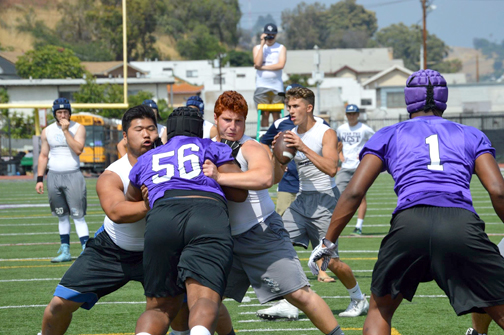
A close eye will be kept on CVHS football players over the next four years as a study is being conducted on CTE by Children’s Hospital and USC.
By Vincent PAGE
A major problem for football players over the past decade, according to research, is concussions. As parents become more aware of the long lasting damage caused by concussions, the most concerning being chronic traumatic encephalopathy, fewer parents are allowing their kids to play football, opting instead for sports such as baseball and basketball.
The research surrounding chronic traumatic encephalopathy, also known as CTE, sent shockwaves after it was discovered by Dr. Bennet Omalu in 2005. He found this degenerative disease in the brains of former football greats. The majority of the players with CTE were offensive lineman and defensive players who consistently used their heads to block and tackle. However, when news was released that former Oakland Raiders quarterback Ken Stabler suffered from CTE, people realized that all football players were vulnerable.
To learn more, the Crescenta Valley High School football organization has teamed up with Children’s Hospital and USC, which have been given a grant to run tests and studies on football players throughout their high school careers. The study will analyze the brains of incoming freshmen football players (who decide to participate). They will be given MRIs each year to see how the brain is affected after one, two, three and then four years of playing football.
With many former NFL players, and even greats such as Hall of Famer Bo Jackson, saying they would have avoided football if they had known about the consequences involving CTE, encouraging kids to choose other sports is important to many. While every sport comes with risks, many feel that the repeated trauma to the head that football can cause makes it riskier to play than other sports.
There have been freak accidents in other sports, though. For example, in baseball there are worries about line drives coming back and hitting pitchers in the head (causing deadly impact) and has given the MLB reason to provide pitchers with protective caps, should they choose to wear them.
“Soccer and cheer have a lot of concussions also. So unless you do nothing there is always a risk. We just try to have the best equipment possible and we try to teach proper tackling,” said CVHS varsity head coach Paul Schilling.
This is why Children’s Hospital, USC and CVHS have agreed to participate in this study. Schilling has been a big supporter of implementing ways to keep players safe over the past few years. All football players at CVHS have sensors in their helmet that detect when they take hard enough hits that can lead to concussions. If their sensors go off, they leave the field and are evaluated to see if they are still fit to play.
Another way the coaching staff has implemented safer play is the newest form of tackling. Hawk tackling has been taught throughout the CVHS program. The term is coined because it was created by Seattle Seahawks coach Pete Carroll. This form of tackling teaches players to lead with their shoulders, not their heads, similar to how rugby players tackle. It keeps the defender safe, and has proven to be an effective way to tackle as well.
Schilling and his staff will continue to find ways to protect their players and it is hoped the conclusions from this study will allow them to further help themselves, their players, doctors and football players everywhere.
